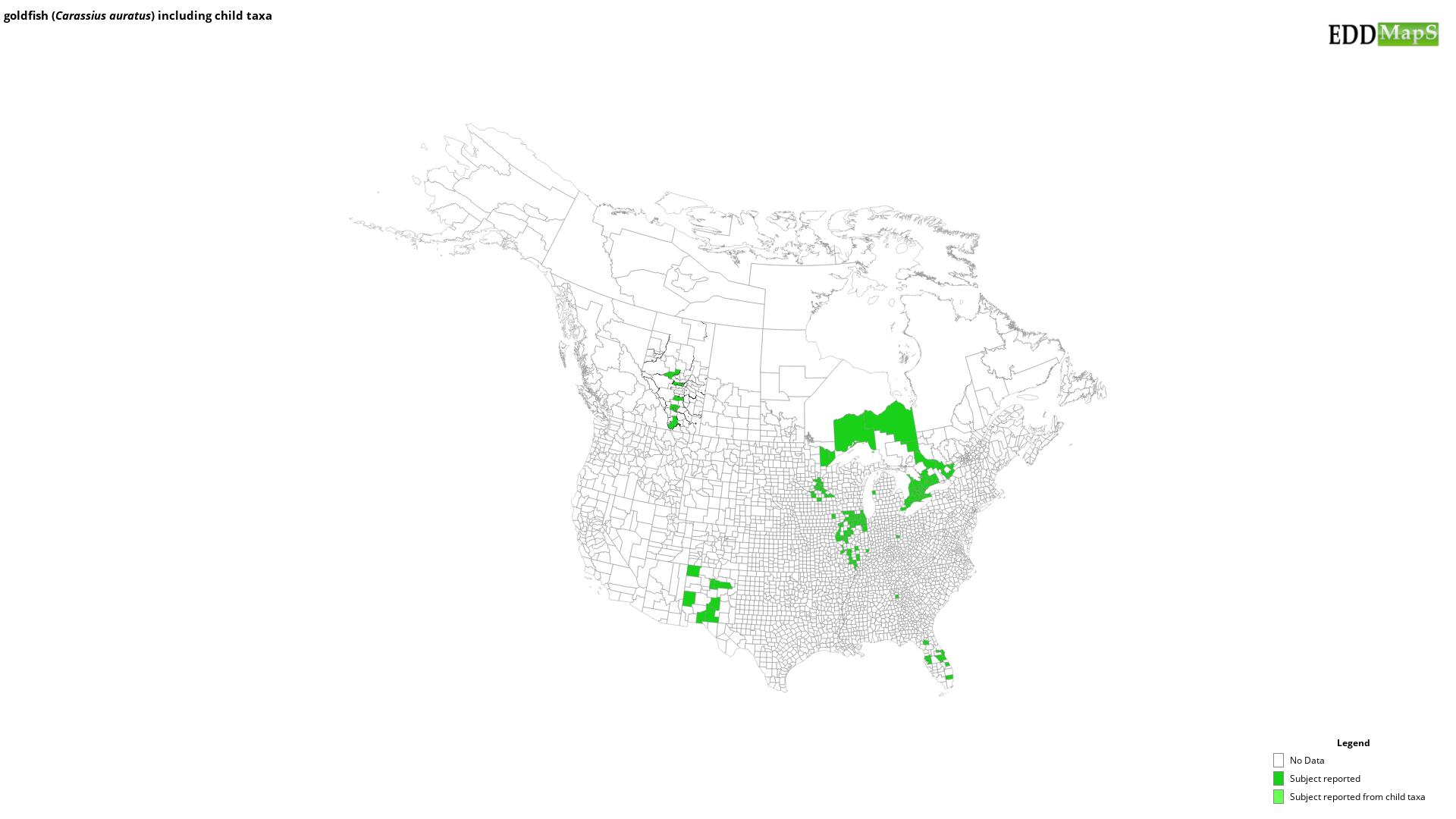goldfish
(Carassius auratus)
This species is Introduced in the United States
Origin
Carassius auratus is native to eastern Asia. Goldfish were introduced to the United States as intentional releases in the 17th century.
Life Cycle
C. auratus are typically between 4.7-8.7 in. (120-220 mm) in length. Wild goldfish vary in coloration with some individuals maintaining their orange color while others are olive-green to silver. C. auratus have 15-21 rays on the dorsal fin, a hard serrated spine, and tails have a deep fork. Male anal fins are concave while female anal fins are convex. This fish species is highly adaptable and tolerates a wide variety of ecosystems. Diet includes detritus, insect larvae, small crustaceans, zooplankton, phytoplankton, fish fry and eggs, and ground-floor vegetation. Female wild goldfish lay approximately 25 eggs that hatch 5 days later. C. auratus have an average lifespan of 7 years.
Distribution
C. auratus are established or reported in all states minus Alaska.
Control Efforts
C. auratus can transmit parasites and bacteria to native species. Although not considered a “pest species”, wild goldfish have the potential to establish large populations.
http://www.tsusinvasives.org/home/database/carassius-auratus
https://nas.er.usgs.gov/queries/FactSheet.aspx?speciesID=508
Carassius auratus is native to eastern Asia. Goldfish were introduced to the United States as intentional releases in the 17th century.
Life Cycle
C. auratus are typically between 4.7-8.7 in. (120-220 mm) in length. Wild goldfish vary in coloration with some individuals maintaining their orange color while others are olive-green to silver. C. auratus have 15-21 rays on the dorsal fin, a hard serrated spine, and tails have a deep fork. Male anal fins are concave while female anal fins are convex. This fish species is highly adaptable and tolerates a wide variety of ecosystems. Diet includes detritus, insect larvae, small crustaceans, zooplankton, phytoplankton, fish fry and eggs, and ground-floor vegetation. Female wild goldfish lay approximately 25 eggs that hatch 5 days later. C. auratus have an average lifespan of 7 years.
Distribution
C. auratus are established or reported in all states minus Alaska.
Control Efforts
C. auratus can transmit parasites and bacteria to native species. Although not considered a “pest species”, wild goldfish have the potential to establish large populations.
http://www.tsusinvasives.org/home/database/carassius-auratus
https://nas.er.usgs.gov/queries/FactSheet.aspx?speciesID=508
Resources
- Nonindigenous Aquatic Species Database - U.S. Geological Survey
- Fact Sheet - Ontarios Invading Species Awareness Program
Selected Images
Maps
EDDMapS Distribution - This map is incomplete and is based only on current site and county level reports made by experts, herbaria, and literature. For more information, visit www.eddmaps.org
State Lists - This map identifies those states that have this species on their invasive species list or law.
Invasive Listing Sources
- Invasive Species of Concern in Georgia
- Maryland Invasive Species Council - Invasive Species of Concern in Maryland
- Mid-Atlantic Field Guide to Aquatic Invasive Species
- Minnesota DNR invasive species list
- New York Regulated and Prohibited Invasive Species - Regulated
- Nonnative Invasive Species in Southern Forest and Grassland Ecosystems
- Ontario’s Invading Species Awareness Program Tracked Species List
- Pennsylvania's Field Guide to Aquatic Invasive Species
- West Virginia Invasive Species Strategic Plan and Volunteer Guidelines 2014
- Wisconsin's Invasive species rule – NR 40
Taxonomic Rank
| Domain: Eukarya |
| Kingdom: Animalia |
| Phylum: Chordata |
| Subphylum: Vertebrata |
| Class: Actinopterygii |
| Subclass: Neopterygii |
| Order: Cypriniformes |
| Family: Cyprinidae |
| Genus: Carassius |
| Carassius auratus |


